1932 – 1956
In the late twenties, the Depression hit hard on the world’s ship-owners. One of the companies that was most affected by this was the White Star Line. Before the crash occurred in 1929, the Cunard Line, the White Star Line and the French Line had one ship each well ahead in plans. The Cunard ship was the Queen Mary, the White Star ship was the Oceanic and the French ship was the Normandie. All of these ships should be able to maintain a service speed of 30 knots, and exceed a thousand feet in length. When the crash came, only the Oceanic was under construction at Harland and Wolff’s shipyard. The White Star, who had the most precarious economic situation, cancelled the order on the Oceanic soon after the crash. The Queen Mary, whose construction began in 1930, was not cancelled but put on hold. The only ship of these three that continued its construction was the French Line’s Normandie.
The Oceanic’s keel had already been laid, though, and the White Star Line did not want to waste good steel. Realising that they had not a strong enough economic situation, they instead of the thousand-feet Oceanic ordered a new smaller vessel from Harland and Wolff. They took the cancelled Oceanic’s keel and recycled it into what was going to be the 27,000-tonner Britannic. That ship had her maiden voyage in June 1930, and became somewhat of a success, despite the facts that she only had a service speed of 18 knots and was something totally new in the conservative public’s eyes. Even though ordered to have an ‘Olympic-class resemblance’, she had a blunt stern and two squat funnels. (The forward funnel was a dummy, which contained the radio room and the engineering officer’s smoking room.) But, the popularity continued and soon the White Star Line decided that they would add a sister to the Britannic.
The sister was launched on November 12, 1931, and was christened Georgic. Now the White Star Line could once again claim to operate a new duo of ships on the North Atlantic, and that was something rather rare. Since the ships was not in the class of Majestic and Olympic none of them was given the rank of flagship. The Southampton-New York route was maintained by the Majestic and the Olympic, whilst the Liverpool-New York route was mainly taken over by Britannic and Georgic.
In appearance, the Georgic looked somewhat different from the Britannic. She had a more rounded bridge-front and some of her windows on the superstructure differed from her sister’s.
On June 4, 1932, the Georgic went through her sea trials. During these she carried guests which had been ferried out to her on the Belfast S.S. Co.’s Ulster Monarch, which had been chartered for the occasion. Six days later she was handed over to the White Star Line. On June 25, the Georgic set out on her maiden voyage between Liverpool and New York. She managed superbly, and arrived at New York twelve hours early. In September the same year a charity banquet was held on the Georgic while she lay in the Gladstone Dock. Later during the off-season of the year, just as her sister Britannic, the Georgic was used cruising from New York.
In 1933 the Olympic was considered old enough to be replaced by the Georgic. Thus was her new home port Southampton and her route therefore Southampton-New York. In spite of this she continued some of her Liverpool service, and at one occasion in October the Georgic landed a 3,000 ton record cargo of fruit at Liverpool.
In 1934, the White Star Line could not resist the economic pressure any longer. They were forced by the government to merger with Cunard; in order to have the government finance the Queen Mary-project, which had been on hold for years. In the new company there would be ten directors of which four were from the White Star Line. Obviously, Cunard had the upper hand in the Cunard-White Star Line, but all of White Star’s ships continued to wear their old colours, including Georgic.
In this new company, the Georgic, together with the Britannic started to sail on the London-Southampton-New York service, and in May 1935, she made her first sailing on this route. Because she was slightly larger that the Britannic, the Georgic became the largest ship to operate in the River Thames. Cunard’s new Mauretania at 35,000 tons used the port once, but did not thereafter use it anymore, so the honour belongs to Georgic.
The Second World War began in 1939, and the Georgic was requisitioned for British trooping duties. Earlier the same year the Georgic had been transferred back to the Liverpool-New York service and made five voyages back and forth. The actual converting into a trooping-vessel did not occur until April 1940, on the Clyde. The Georgic was now able to carry 3,000 soldiers. The first use that was made of the Georgic was to have British troops evacuated from Andesfjord and Narvik in Norway and landing them at the Clyde. The next assignment was to evacuate British soldiers from Brest and S:t Nazarie. She also carried Canadian troops across the Atlantic to the Middle East via the way around Africa.
In 1941, the Georgic was sailing in a convoy that had left the Clyde on May 22. This convoy was the very convoy, which hunted and sank the famous German battleship Bismarck. After having been left almost unprotected by the attacking British war-ships, the Georgic anyway managed to reach her destination: Port Tewfik in the Gulf of Suez on July 7. When she was at anchor here, German aircraft spotted the British trooper and bombed her. The Georgic was hit twice, and the stern of the ship was set afire by the bombs. The fire reached the ship’s fuel, and the ammunition carried on board exploded, thus wrecking the entire stern area. The ship was beached by her captain, and when evacuated the half-submerged Georgic was left to be burned out.
Even though the vessel was almost totally destroyed, it was decided that she should be salvaged on September 14. In October the Georgic was raised, and two months later the plugging of the hull was completed. She was towed, stern first, to Port Sudan where she was made seaworthy. A year later she had arrived at Bombay and finished hull cleaning and further reparations. In January 1943, she left Bombay at 16 knots for Liverpool where she arrived on March 1. Her next port of call was Belfast. There she would undergo a complete refit, which took 17 months. When completed in December 1944, her exterior was much different from what she had once looked like. The main changes was that her fore funnel and aft mast had been removed and the forward mast been shortened. Now every possible difficulty in separating Georgic from her sister Britannic had been reduced. On December 16, she was returned to her managers. During the last year of the war, the Georgic made some trooping to Italy, the Middle East and India. The last war duties continued until 1948.
The same year, the Georgic was refitted for civil use by Palmers’ and Co. Hebburn. She was intended to sail on the Australian and New Zealand immigrant service. The Georgic’s passengers were now only able to travel in one class; since the German bombing the ship could not retain first class service. In January 1949, the Georgic made her first sailing on the new route with Liverpool as her starting point. During this very first voyage, she had a rope wrapped around a propeller, and she had to re-dock.
In 1950, the name White Star forever disappeared from the scene. However, the surviving White Star ships in Cunard service, namely the Britannic and Georgic, continued to sail in White Star livery, and still hoisted the White Star flag. Between 1951 and 1954, the Georgic sailed Southampton-New York during the summers. Her final voyage was on October 19.
The Georgic was offered for sale in 1955, and in May she was chartered by the Australian Government. This was to be her final year of service, as she sailed from Liverpool in August 1955 to Australia via Cape Town with 2,000 Emigrants to Australia. At Sydney the Georgic loaded 3,000 Australian troops of the Royal Australian Regiment and took them to Penang in Malaya for the war there. The ship was then sent to Vung Tau in Vietnam to rescue 2,500 French Foreign Legionnaires and took them to Algiers and Marseilles, thereafter sailing into Liverpool empty. After a couple of weeks the Georgic sailed for the Clyde, and her crew left the ship on 12 December 1955 to await the ship breakers. Later in December she was laid up at Kames Bay at Isle of Bute, and in January 1956 she was sold to the Shipbreaking Industries Ltd. at Faslane where she arrived one month later. The last of the ships built for the White Star Line had finally come to rest.
Specifications
- 712 feet (217.5 m) long
- 82.5 feet (25.2 m) wide
- 27,759 gross tons
- Burmeister & Wain diesels powering two propellers
- 18 knot service speed
- Passenger capacity of 1,063 people

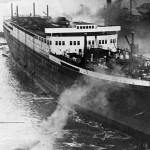
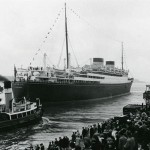
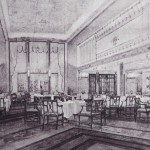
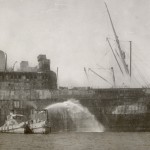
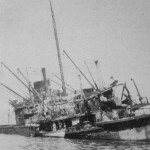
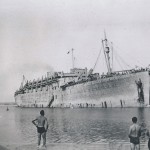
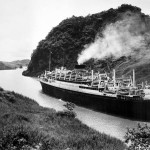
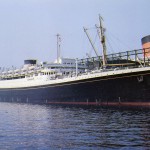
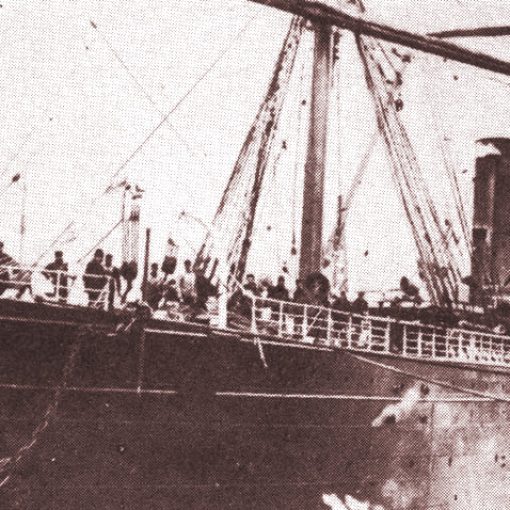
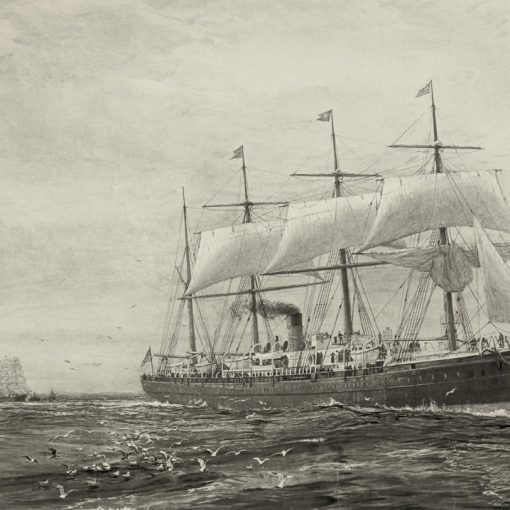
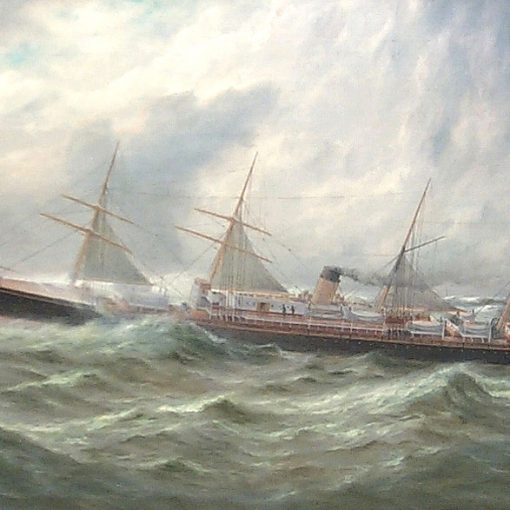
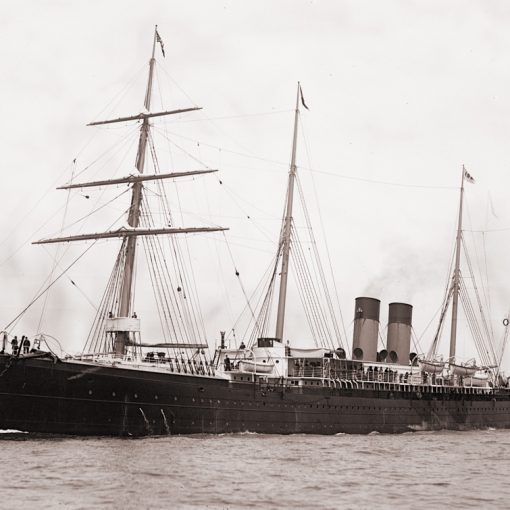
One thought on “Georgic (II)”
I haven’t seen it in print anywhere but the MV Georgic also traveled from New York to Havana, Cuba. I don’t know how many times it made that trip but it did go to Havana from New York from January 15, 1938 to at least January 23, 1938. My grandparents were on the ship and I have a luggage tag, two menus, an MV Georgic doll and a doll from Havana, all from that cruise.